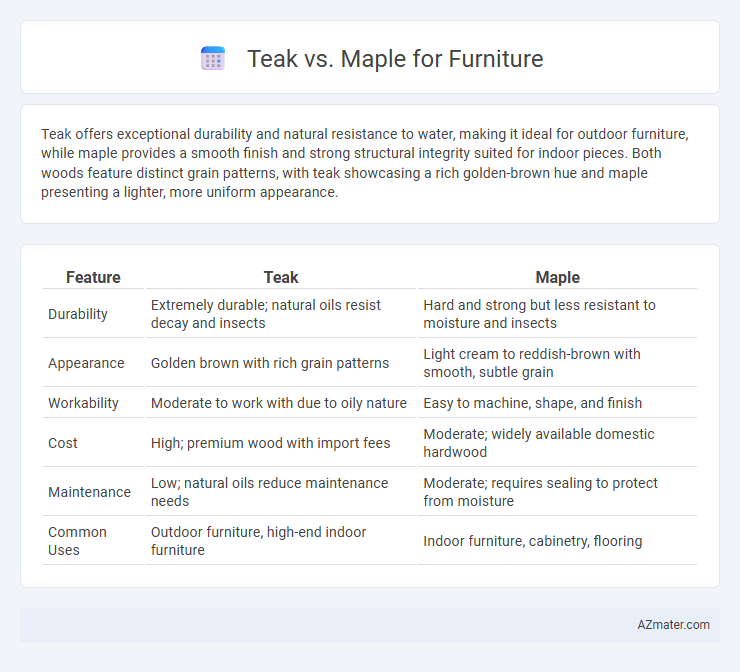Teak offers exceptional durability and natural resistance to water, making it ideal for outdoor furniture, while maple provides a smooth finish and strong structural integrity suited for indoor pieces. Both woods feature distinct grain patterns, with teak showcasing a rich golden-brown hue and maple presenting a lighter, more uniform appearance.
Table of Comparison
| Feature | Teak | Maple |
|---|---|---|
| Durability | Extremely durable; natural oils resist decay and insects | Hard and strong but less resistant to moisture and insects |
| Appearance | Golden brown with rich grain patterns | Light cream to reddish-brown with smooth, subtle grain |
| Workability | Moderate to work with due to oily nature | Easy to machine, shape, and finish |
| Cost | High; premium wood with import fees | Moderate; widely available domestic hardwood |
| Maintenance | Low; natural oils reduce maintenance needs | Moderate; requires sealing to protect from moisture |
| Common Uses | Outdoor furniture, high-end indoor furniture | Indoor furniture, cabinetry, flooring |
Teak vs Maple: An Introduction
Teak and maple are two popular hardwoods used in furniture making, each offering distinct benefits. Teak is renowned for its rich golden-brown color, natural oil content that enhances durability, and exceptional resistance to water and pests, making it ideal for outdoor furniture. Maple features a lighter, creamy appearance with a smooth grain pattern and is prized for its strength and resistance to abrasion, often favored for indoor furniture pieces requiring a sleek, modern look.
Appearance and Grain Differences
Teak furniture showcases a warm golden-brown hue with a naturally oily texture that enhances durability and water resistance, featuring a straight to wavy grain pattern that adds a rich, tropical character. Maple furniture displays a lighter, creamy white to reddish-brown color with a smooth, fine grain that often appears subtle and uniform, contributing to a sleek, contemporary look. The contrasting aesthetics of teak's bold grain and maple's understated elegance offer diverse design options for furniture, influencing style and ambiance.
Durability and Longevity Comparison
Teak wood is renowned for its exceptional durability and natural resistance to moisture, insects, and decay, making it ideal for outdoor and high-traffic furniture. Maple, while hard and dense with strong resistance to wear and dents, is more susceptible to moisture damage and requires regular maintenance to prolong its lifespan. Teak's high oil content and tight grain structure contribute to its superior longevity, often lasting decades without significant deterioration compared to maple.
Maintenance Requirements
Teak furniture requires minimal maintenance due to its natural oils that resist water, insects, and decay, making it ideal for outdoor use with occasional cleaning and oiling to maintain its golden hue. Maple furniture demands more upkeep, including regular dusting and periodic sealing or finishing to protect against moisture and scratches, as its porous wood is prone to wear and staining. Choosing teak reduces long-term upkeep efforts, whereas maple offers a cost-effective option that benefits from consistent care to preserve durability and appearance.
Resistance to Moisture and Decay
Teak wood is highly resistant to moisture and decay due to its natural oils and dense grain, making it ideal for outdoor furniture. Maple, though strong and durable, is more susceptible to water damage and fungal decay without proper sealing and maintenance. Choosing teak ensures longer-lasting furniture in humid or wet environments, whereas maple requires additional protection to withstand moisture exposure.
Sustainability and Environmental Impact
Teak furniture, known for its natural resistance to pests and water, offers longevity that reduces the need for frequent replacements, promoting sustainability. Maple wood, abundant and fast-growing, is a renewable resource with a shorter harvest cycle, contributing to lower environmental impact. Choosing sustainably sourced teak or certified maple ensures responsible forestry practices that support ecosystem conservation.
Cost and Value Analysis
Teak furniture typically commands a higher price due to its unparalleled durability, natural resistance to moisture and pests, and rich, warm tones that enhance long-term value. Maple, while more affordable and easier to work with, offers less natural weather resistance, often requiring additional protective finishes to maintain its appearance and longevity. Investing in teak provides greater cost efficiency over time through reduced maintenance and excellent resale value, whereas maple suits budget-conscious buyers seeking versatile indoor furnishings.
Workability and Crafting Ease
Teak wood offers excellent workability due to its moderate density and natural oils, which enhance durability but can sometimes clog tools during crafting. Maple, known for its fine, even grain and hardness, allows for smooth cutting and shaping, making it a preferred choice for detailed woodworking projects. Crafting with maple is generally easier than teak, as it requires less specialized tooling to achieve precise finishes and intricate designs.
Common Uses in Furniture Design
Teak is highly valued in outdoor furniture design for its exceptional durability, natural resistance to water, and rich golden-brown color that ages beautifully over time. Maple furniture is commonly used for indoor pieces such as cabinets, tables, and chairs due to its fine, even grain and strong, hardwearing properties that allow for smooth finishes and intricate detailing. Both woods are favored in furniture design, with teak preferred for outdoor settings and maple dominating indoor applications where precision and aesthetics are essential.
Choosing Between Teak and Maple
Teak offers unparalleled durability and natural resistance to moisture and pests, making it ideal for outdoor furniture and humid environments. Maple provides a smooth, fine grain and is highly versatile for indoor furniture, excelling in strength and ease of finishing. Choosing between teak and maple depends on the intended use, environmental exposure, and desired aesthetic, with teak suited for long-lasting outdoor applications and maple preferred for refined indoor pieces.

Infographic: Teak vs Maple for Furniture
 azmater.com
azmater.com